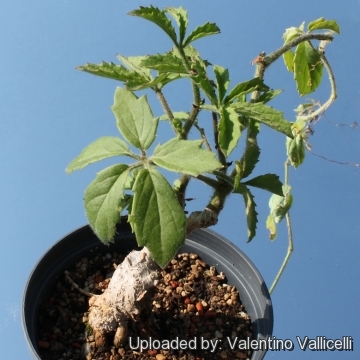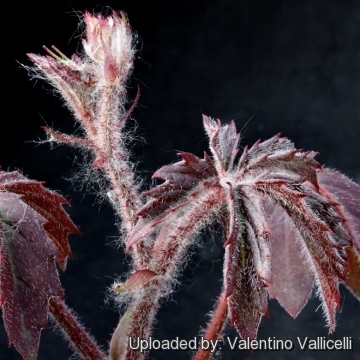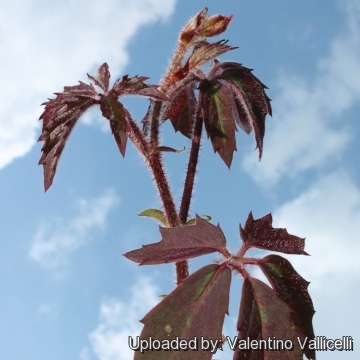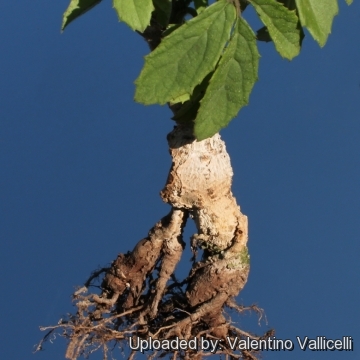Accepted Scientific Name: Cyphostemma cirrhosum (Thunb.) Desc. ex Wild & R.B.Drumm.
Fl. Zambes. 2: 485. 1966 Exell & Wild

Cyphostemma sandersonii Photo by: Valentino Vallicelli
Origin and Habitat: South Africa.
Habitat: It occurs usually among rocks in the bushland
Synonyms:
See all synonyms of Cyphostemma cirrhosum
back
Accepted name in llifle Database:Cyphostemma cirrhosum (Thunb.) Desc. ex Wild & R.B.Drumm.Fl. Zambes. 2: 485. 1966Synonymy: 10
back
Common Names include:
ENGLISH: Felted Grape Tree
Description: Semi-rambling plant with woody stems and fleshy leaves.
Leaves: S-foliolate, leaflets obovate, coarsely toothed, softly puberulous below.
Flowers: Green.
Fruit: Grow edible fruit.
Remarks: Cissus sandersoniiSN|15653]]SN|15653]] Harv. After a study of a wide range of modern material, it is concluded that this cannot be satisfactorily separated from Cyphostemma cirrhosumSN|15644]]SN|15644]].
Bibliography: Major references and further lectures
1)Umberto Quattrocchi “CRC World Dictionary of Medicinal and Poisonous Plants: Common Names, Scientific Names, Eponyms, Synonyms, and Etymology” (5 Volume Set) CRC Press, 03/May/2012
2) Gordon Rowley “Caudiciform and Pachycaul Succulents: Pachycauls, Bottle-,Barrel-And Elephant-Trees and Their Kin a Collector's Miscellany” Strawberry Press. June 1st 1987
3) Werner Rauh “The Wonderful World of Succulents: Cultivation and Description of Selected Succulent Plants Other Than Cacti” Smithsonian Institution Press, 1984
More... Cyphostemma sandersonii Photo by: Valentino Vallicelli
Cyphostemma sandersonii Photo by: Valentino Vallicelli Cyphostemma sandersonii Photo by: Valentino Vallicelli
Cyphostemma sandersonii Photo by: Valentino Vallicelli Cyphostemma sandersonii Photo by: Valentino Vallicelli
Cyphostemma sandersonii Photo by: Valentino Vallicelli Cyphostemma sandersonii Photo by: Valentino Vallicelli
Cyphostemma sandersonii Photo by: Valentino VallicelliCultivation and Propagation: Cyphostemma sandersoniiSN|15652]]SN|15652]] is one of the smaller-growing adenias that creates an dense shrub if not manicured. It should make an interesting addition to a collection. It is suited to greenhouse culture, but does well out of doors outdoors in frost-free climates. It doesn't like a wet winter, but will survive.
Growth rate: It grows well, though very slowly, but it possible to increase the speed of growth to some extent by providing adequate amount of water, warmth, and fertilizer during the active growing season, but it’s susceptible to rotting if too wet.
Exposure: It needs Full sun to light shade, but the caudex should be in the shade, while the leaves prefer the sun. Avoid direct blasting sun in summer.
Soil: It needs a a rich, very well drained potting medium (add pumice, vulcanite, and perlite).
Waterings: It should be watered plentifully in Summer and kept drier in Winter. This species like all pachycaul succulent species of Cyphostemma, is sensitive to excess moisture, and should be kept on the dry side. It rot easily and do NOT like a lot of water when it has no leaves.
Frost tolerance: Due to its African origin keep warm in winter, the minimum safe average temperature is 12°C, although it can go lower for short periods. It can be grown outdoors in frost-free climates, need anyway to kept above 2°C and dry in winter. Can't stand any frost.
Manteinance: Repot every two years. It like pots with generous drain holes. Once this plant is established in its new pot, it should be cut back in height to encourage branching, to maintain an attractive shape and to ensure caudex habit. If pruned and kept somewhat pot bound, it can be maintained at a manageable size, depending on what ''manageable size'' means to you.
Propagation: The plants for decoration are grown from seed since they develop a perfect caudex. The seeds that must be prepared, aged and scarified, and even then germination is uncertain (cuttings are possible, but don't generally produce a caudex).
More...














